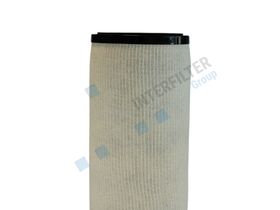Coalescer and separator filters
Solids removal, coalescer and separator filters
Solids removal, coalescer and separator filter elements are widely used in filtration systems to separate liquids, mainly oil and water, or to remove contaminants from air and gas streams. The filters are used in various industrial processes, such as in oil and gas production, aviation, chemical processing, and water treatment.
Differences between solids removal, coalescer, and separator
Function
- Solids removal: removes solid particles (such as dirt, sand, dust, rust) from the stream.
- Coalescer: collects and combines small liquid droplets (such as water in oil or gas, or oil in water) into larger droplets.
- Separator: separates the larger droplets formed by the coalescer from the stream without allowing them to mix again. For example, water droplets removed from fuel.
Material
- Solids removal: usually made of sturdy, durable materials such as stainless steel or synthetic fibers resistant to erosion.
- Coalescer: often made of fine fibrous materials that attract and combine liquids such as water, such as fiberglass or polyester.
- Separator: made of hydrophobic (water-repellent) materials such as PTFE or Teflon, which repel liquids like water.
Use
- Solids removal: placed first in the filtration system. This filter prevents solid particles from clogging or damaging downstream filters (coalescer and separator).
- Coalescer: used in the second step of the process to combine liquid droplets.
- Separator: used in the final step to separate the formed larger droplets and prevent further contamination.
Non-binding filter advice
For more information, you can read the page of a specific filter or contact one of our specialists. We are happy to help you select the right filters for your process.
 EN
EN
 NL
NL PL
PL 


